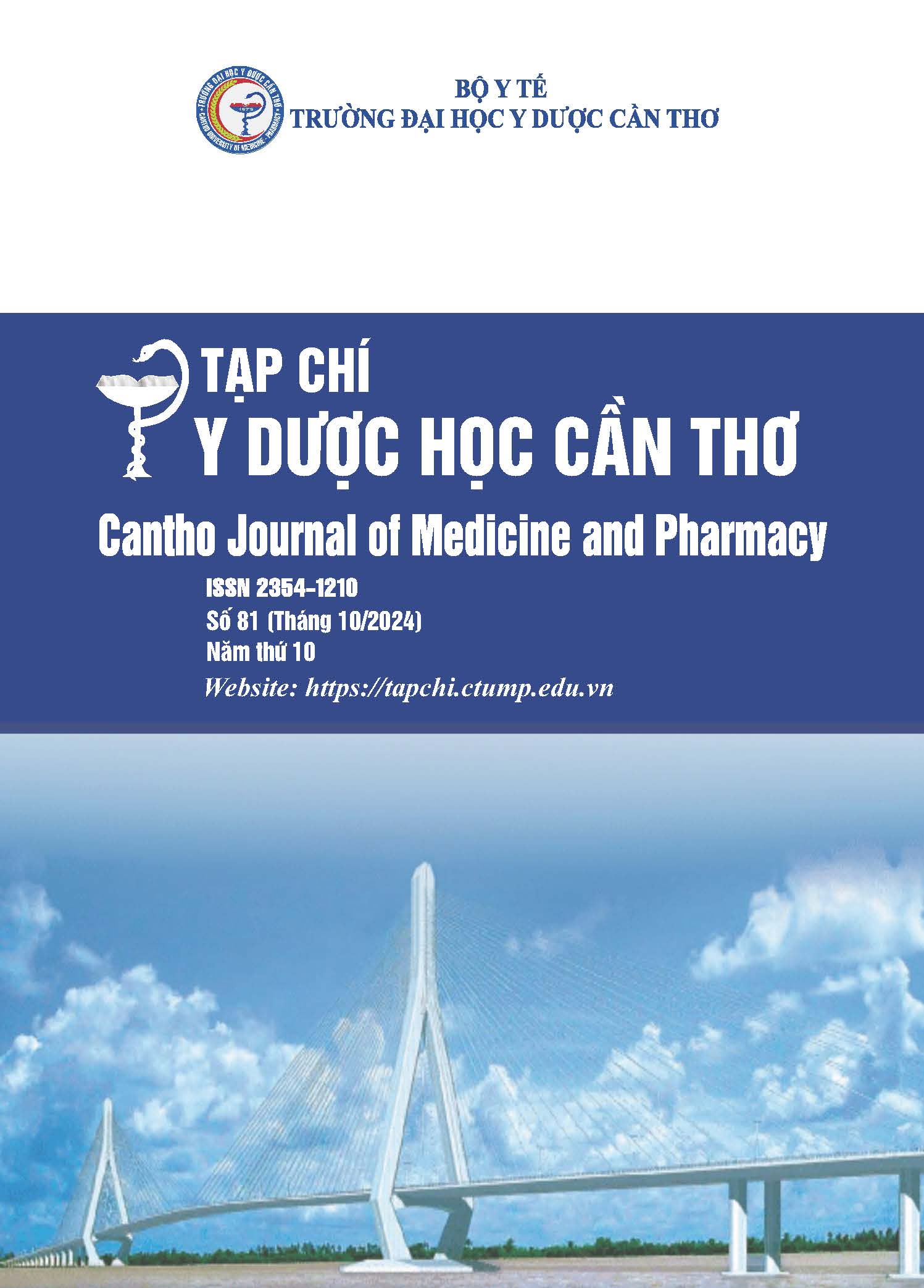CLINICAL, LABORATORY CHARACTERISTICS, AND PREDICTIVE FACTORS FOR SEVERITY IN CHILDREN WITH DENGUE HEMORRHAGIC FEVER
Main Article Content
Abstract
Background: Dengue fever is a viral infection caused by the Dengue virus, capable of rapid progression to severe disease and potentially fatal outcomes. Early diagnosis of severe Dengue is crucial to minimize serious consequences. Objectives: To describe clinical and laboratory characteristics and identify prognostic factors for severe Dengue hemorrhagic fever in children. Materials and methods: A analytical cross-sectional study was conducted on 147 children diagnosed with Dengue hemorrhagic fever admitted to Can Tho Children's Hospital from 2022 to 2024. Results: Among 147 children enrolled, 22.4% progressed to severe Dengue. The mean age was 10.3 years, with males accounting for 57.1% and 21.7% being overweight or obese. Common clinical manifestations included mucosal bleeding (28.6%), hepatomegaly >2 cm (22.4%), right upper quadrant (RUQ) pain (20.4%), and skin erythema (19%). Symptoms more prevalent in the severe group than in the non-severe group were RUQ pain (42.4% vs. 14%), frequent vomiting (30.3% vs. 8.8%), and headache (18.2% vs. 4.4%) (p<0.05). Laboratory findings revealed 70.1% had leukopenia (≤5,000/L), 54.4% had prolonged prothrombin time (PT >13 sec), 42.9% had elevated hematocrit (≥42%), and 36.1% had low fibrinogen (<2 g/L). Severe cases commonly exhibited hematocrit ≥42% (75.8%), fibrinogen <2 g/L (63.6%), prolonged activated partial thromboplastin time (aPTT >40 sec) (57.6%), thrombocytopenia (≤50,000/uL) (54.5%), hypoalbuminemia (≤30 g/L), and elevated lactate (≥2 mmol/L) (36.4%). Factors associated with severe Dengue prognosis included RUQ pain, headache, frequent vomiting, thrombocytopenia (≤50,000/L), elevated hematocrit (≥42%), hypoalbuminemia (≤30 g/L), elevated lactate (≥2 mmol/L), prolonged aPTT (>40 sec), and low fibrinogen (<2 g/L) (p<0.05). Conclusion: Significant differences in certain clinical and laboratory features were observed between children with progression to severe and non-severe Dengue. These variables were also independently associated with the prognosis for severe Dengue hemorrhagic fever.
Article Details
Keywords
Dengue hemorrhagic fever, prognostic factor, clinical features, laboratory features
References
2. Lê Thị Thúy Hằng, Nguyễn Trần Ngọc Hiếu, Phạm Hải Yến, Vũ Thị Minh Thư, Trần Văn Duy và cộng sự. Nghiên cứu một số đặc điểm lâm sàng và các yếu tố tiên lượng nặng của bệnh nhi sốt xuất huyết Dengue. Tạp chí Y Dược học Quân sự. 2023.48(3), 57-65. https://doi.org/10.56535/jmpm.v48i3.304.
3. Phan Thị Mỹ Trâm, Trần Xuân Chương. Giá trị tiên lượng của chỉ số APRI trong bệnh sốt xuất huyết Dengue. Tạp chí Truyền nhiễm Việt Nam. 2023.2(42), 102-105. https://doi.org/10.59873/vjid.v2i42.289.
4. Bộ Y tế. Hướng dẫn chẩn đoán điều trị sốt xuất huyết. Quyết định số 3705/QĐ-BYT ngày 22 tháng 8 năm 2019 của Bộ trưởng Bộ Y tế; 2019.
5. Nguyễn Mậu Thạch, Nguyễn Đình Tuyến, Nguyễn Hữu Châu Đức, Đỗ Duy Thành. Nghiên cứu đặc điểm dịch tễ học, lâm sàng và các yếu tố tiên lượng nặng ở bệnh nhi sốt xuất huyết Dengue tại Bệnh viện Sản - Nhi tỉnh Quảng Ngãi. Tạp chí Nhi khoa. 2024.17(1), 16-23.
6. Lâm Thị Huệ, Nguyễn Ngọc Rạng, Phan Việt Hưng. Đặc điểm lâm sàng, cận lâm sàng và biến chứng ở trẻ em mắc sốt xuất huyết Dengue có tổn thương gan tại Bệnh Viện Nhi Đồng Cần Thơ. Tạp chí Y Dược học Cần Thơ. 2020.(29), 89-95.
7. Đặng Thị Thúy, Bùi Vũ Huy, Ngô Trí Tuấn. Các yếu tố tiên lượng bệnh sốt xuất huyết Dengue dựa vào các Biomarkers. Tạp chí Truyền nhiễm Việt Nam. 2020.2(30), 73-79. https://doi.org/10.59873/vjid.v2i30.163.
8. Huy B.V., Toàn N.V. Prognostic indicators associated with progresses of severe dengue. Johnson C, ed. PLOS ONE. 2022.17(1), e0262096. https://doi.org/10.1371/journal.pone.0262096.
9. Yacoub S., Trung T.H., Lam P.K., Thien V.H.N., Hai D.H.T., et al. Cardio-haemodynamic assessment and venous lactate in severe dengue: Relationship with recurrent shock and respiratory distress. PLoS neglected tropical diseases. 2017.11(7), e0005740. https://doi.org/10.1371/journal.pntd.0005740.
10. Nguyễn Phương Tâm, Nguyễn Ngọc Rạng, Trần Công Lý, Lê Hoàng Mỷ, Nguyễn Khánh Toàn. Khả năng tiên lượng nặng của siêu âm ở trẻ sốt xuất huyết Dengue có dấu hiệu cảnh báo tại bệnh viện Nhi đồng Cần Thơ. Tạp chí Y Dược học Cần Thơ. 2024.(74), 80-86. https://doi.org/10.58490/ctump.2024i74.2427.
11. Nguyễn Trần Ngọc Hiếu, Nguyễn Mạnh Cường, Lê Thị Bích Liên, Đỗ Thiện Hải, Trịnh Minh Đức. Một số đặc điểm lâm sàng, cận lâm sàng liên quan đến mức độ nặng của bệnh nhân nhi từ 1 tháng đến 15 tuổi mắc sốt xuất huyết Dengue. Tạp chí Y Dược học Quân sự. 2023.48(4), 7382. https://doi.org/10.56535/jmpm.v48i4.310.
12. Baiduri S., Husada D., Puspitasari D., Kartina L., Basuki P., et al. Prognostic factors of severe Dengue infections in children. Indonesian Journal of Tropical and Infectious Disease. 2020.8, 44. https://doi.org/10.20473/ijtid.v8i1.10721.
13. Nguyễn Ngọc Rạng, Lâm Thị Huệ. Các chỉ số xét nghiệm tiên đoán sốt xuất huyết Dengue nặng tại Bệnh viện Nhi đồng Cần Thơ. Tạp chí Y Dược học Cần Thơ. 2021.(34), 61-66.
14. Phùng Nguyễn Thế Nguyên, Nguyễn Quý Tỷ Dao, Trần Diệp Tuấn. Rối loạn đông máu ở trẻ sốc sốt xuất huyết Dengue. Tạp chí Y học Việt Nam. 2022.514(2), 169-174. https://doi.org/10.51298/vmj.v514i2.2621.


